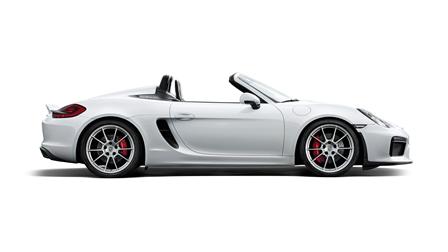
Spyder meets Spyder
Mark Webber and the new Spyder taking the roads through Buckinghamshire on their way to Silverstone.
Home round with two of the purest roadsters: Factory driver Mark Webber at the wheel of the brand-new
The road from Mark Webber’s house, just outside Aylesbury, some 70 kilometers northwest of London, to the Silverstone racetrack is rather dull. You travel mostly in a straight line, and the traffic is always heavy, even when you travel outside rush hour. This circumstance is not encouraging, given it is the only time he has to try the brand-new
Mark takes one look at the car, noting its additional spoilers, new rear deck, and lowered suspension. He knows already it has the 276 kW (375 hp), 3.8-liter motor from the
The perfect drive: The morning sun above and the boxer engine behind the driver.
It might seem strange to say it, but many race-car drivers aren’t that interested in cars: to them they are merely the means by which their talent is expressed and victories achieved. Mark Webber is an exception. He loved
We have barely left the village before Mark is eulogizing about the
So how does this nine-time winner of Formula One races drive? Expertly, quickly, but with no drama at all. He reaches the speed he wants, and then uses the
![[+]](https://files.porsche.com/filestore/image/multimedia/none/rd-2015-christophorus-issue372-article02-content-01/normal/46e9821d-104c-11e5-bccb-001a64c55f5c/porsche-normal.jpg)
The power of 276 kW (375 hp) from a bird’s-eye view:
There is no radio, no air-conditioning, and no PDK—only the six-speed manual gearbox.
Mark changes gears so smoothly, you might think the car had a PDK transmission instead of a six-speed manual gearbox, so I ask him which he prefers. “Some people think manual transmissions are out of date, others that paddle-shift boxes take the fun away. I genuinely like both. Obviously, we have to use paddles in the race car, and in a normal road car I’d also choose paddles, unless the manual gearbox was amazing.” Then another huge smile spreads across his face, and he shifts down from fourth to third, momentarily opening the throttle by himself: “And this manual is amazing,” he laughs.
As for the engine, the biggest ever fitted to a
Silverstone is getting closer now, and, sensing the journey’s end, Mark briefly makes full use of the car’s performance, with the engine howling its approval. It lasts only a few seconds, but it is enough to impress a race-car driver used to being given only the best of the best to drive. “What else can you buy for the same money that can do that?” he exclaims. “This car is quiet and comfortable enough for us to be able to chat all the way here, and then, when you want, provide a level of dynamic involvement that would be pretty rare to find in any car, let alone one as affordable as this.”
History lesson: The 550 Spyder provided the inspiration for the
Our journey is over, but the fun has only just begun. Mark may be here to race his 919 Hybrid, but first, sitting by the test track belonging to the Silverstone-based
This
Time is short, and
![[+]](https://files.porsche.com/filestore/image/multimedia/none/rd-2015-christophorus-issue372-article02-content-02/normal/b0a20d69-104f-11e5-bccb-001a64c55f5c/porsche-normal.jpg)
Two mid-engine sports cars separated by six decades in time but just centimeters on the track.
Mark Webber is a
I feared that even with Mark Webber driving, I might not have much work to do behind a car so old and with an engine so small, but I soon realized I had underestimated both the car I was following and the man driving it. The 550 A has been prepared to race at Le Mans, and it’s clear from the speed he is driving, the instant gearshifts, and the way he precisely positions the car around the track that Mark is completely comfortable with the car. Lap after lap we go faster and faster, the smooth snarl of the
Too soon our time is up, and Mark heads back to the pits. He’s talking even before he gets out of the car. “That was incredible. I expected it to sound good and even thought it might be quite quick, but the real surprise is how together it feels.”
“If you look at it, you see how well
What didn’t he like, I ask. “The only area in which the car seems its age is the brakes. The drums don’t slow you much, and the pedal feel is not great either. Other than that, it felt years ahead of its time.”
Someone is calling Mark. He has team meetings before the race, and his time with us is over. Just before he leaves I ask him what else, other than their design similarities, he thinks the cars share. “I guess it’s that
By Andrew Frankel
Photos by Paul Barshon
Gallery.
New opening hours
Light, easy-to-operate, and absolutely ready for everyday use: the
The
This is how the manual quick-folding top is opened.
![[+]](https://files.porsche.com/filestore/image/multimedia/none/rd-2015-christophorus-issue372-article02-content-03/normal/3aca05f8-2647-11e5-b369-0019999cd470/porsche-normal.jpg)
The top in the closed position with the characteristic fins stretching far to the back.
![[+]](https://files.porsche.com/filestore/image/multimedia/none/rd-2015-christophorus-issue372-article02-content-04/normal/500b9626-2647-11e5-b369-0019999cd470/porsche-normal.jpg)
The convertible top and rear lid are electrically unlocked, with a key or convertible top button, and then the fins are removed by hand and fastened to the top.
![[+]](https://files.porsche.com/filestore/image/multimedia/none/rd-2015-christophorus-issue372-article02-content-05/normal/6080ded0-2647-11e5-b369-0019999cd470/porsche-normal.jpg)
Next you open the rear lid and stow the top in the convertible top compartment.
![[+]](https://files.porsche.com/filestore/image/multimedia/none/rd-2015-christophorus-issue372-article02-content-06/normal/7a983c06-2647-11e5-b369-0019999cd470/porsche-normal.jpg)
Then the rear lid and, finally, the side cover flaps are closed.
![[+]](https://files.porsche.com/filestore/image/multimedia/none/rd-2015-christophorus-issue372-article02-content-07/normal/8858d36d-2647-11e5-b369-0019999cd470/porsche-normal.jpg)
With the top down, the convertible top is stowed beneath the rear lid with the two striking streamliners.
![[+]](https://files.porsche.com/filestore/image/multimedia/none/rd-2015-christophorus-issue372-article02-margin-01/normal/12593f9d-104b-11e5-bccb-001a64c55f5c/porsche-normal.jpg)
![[+]](https://files.porsche.com/filestore/image/multimedia/none/rd-2015-christophorus-issue372-article02-margin-02/normal/c1a2c649-104b-11e5-bccb-001a64c55f5c/porsche-normal.jpg)
![[+]](https://files.porsche.com/filestore/image/multimedia/none/rd-2015-christophorus-issue372-article02-margin-03/normal/fb01b7bd-104c-11e5-bccb-001a64c55f5c/porsche-normal.jpg)
![[+]](https://files.porsche.com/filestore/image/multimedia/none/rd-2015-christophorus-issue372-article02-margin-04/normal/6ad26a02-104d-11e5-bccb-001a64c55f5c/porsche-normal.jpg)
![[+]](https://files.porsche.com/filestore/image/multimedia/none/rd-2015-christophorus-issue372-article02-margin-05/normal/6baa1071-1050-11e5-bccb-001a64c55f5c/porsche-normal.jpg)











